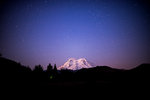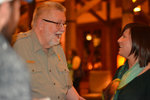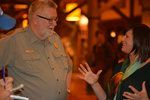


It’s a rainy night on Mount Rainier, and dozens of visitors to the national park have gathered in the cozy confines of the Paradise Inn Saturday to hear Allison Barto talk about the stars.
Barto, an astrophysicist, is one of the private-sector leaders on NASA’s James Webb Space Telescope project, the ambitious successor to the Hubble Space Telescope that will one day give us new looks into deep space. As a fireplace crackles at the back of the rustic lodge, kids and parents alike are captivated as she describes how its giant mirrors will peer into galaxies 13 billion light-years away, how its tennis court-sized sunshields can drop temperatures by 500 degrees.
Volunteers and park staff regularly give lectures like Barto’s on astronomy, plants and animals and other topics as part of regular programming at Paradise Inn and around the park.
One audience member Saturday was particularly transfixed, standing quietly to the side, eyes on the speaker. Jim Ross, a seasonal worker with the National Park Service, has been coming to Rainier for 52 years. Three decades ago, he gave an astronomy talk to park visitors, telling them about the mythology and science of the stars. It was one of many he gave in the 10 or so summers he led groups up to Backbone Ridge on clear nights. On that particular night, though, a 10-year-old camper was filled with wonder. She decided she wanted to be an astrophysicist. That camper was Barto.
For years, Barto has told everyone who’s asked about her career path about that starry night on Rainier — how it sparked an interest in space that’s still burning. For the past 20 years, she’s been with Ball Aerospace in Boulder, Colo., currently serving as its senior program manager for Webb. Ball is contracted with NASA for the project’s optical technology and mirror system. This summer, the former Seattleite was planning a camping trip to her old stomping grounds, and she thought about the ranger who started it all.
Ross, of course, had no way of knowing one of those long-ago campers had gone on to be a top scientist in a $10 billion project at the leading edge of astronomy. As a teacher at Franklin Pierce High School in Tacoma, he’d gotten to see what many of his students achieved after graduation. But the countless families who came through the park each summer simply went on their way, perhaps having learned a little or at least been entertained.
Barto remembered Ross’s name, though. Her family had attended several of his talks during their annual visits to Rainier.
“My mother was an avid history buff, so we attended every ranger talk there was,” she said, turning to Ross after her presentation. “Growing up, Jim was always there. You were the park.”
That’s where Kevin Bacher came in. Bacher is the park’s volunteer program manager, and he and Ross are good friends. When Barto contacted him with her story, he knew he had to help.
“My jaw just dropped, and my eyes got big,” he said. “I said, ‘Wow, this is just an incredible story.’ We had to figure out how to bring the two of them together.”
Bacher enlisted his wife as a co-conspirator and planned a couples dinner for Saturday with Ross and his wife — ensuring he’d be in the park for Barto’s evening talk. Saturday afternoon, Bacher called Ross over to meet the night’s guest speaker. Barto introduced herself. Then she told Ross about listening to him point out the constellations, about channeling that inspiration, about her career. She thanked him for everything.
“I’m a man of a lot of words, but I didn’t have very many at that time,” Ross said. “I was totally overwhelmed. I just — I’m still getting emotional.”
His friend was equally moved.
“I’m still glowing about it,” Bacher said. “It made my month.”
Hours after meeting Barto, Ross got another treat. He got to be on the receiving end of an astronomy talk at Rainier. Barto held her audience captive, visitors straining forward in their seats, gasps of “wow” audible now and again. She made astrophysics into an all-age affair, using an inflating balloon to illustrate the expansion of the universe. The smoothness of Webb’s mirrors isn’t just measured in nanometers — it’s equivalent to the United States having no mountains or valleys greater than three inches. Heads nodded as her illustrations provided a frame of reference.
It’s this way of making science relatable that Ross brought to park visitors for so many years. He’s currently the park’s outreach director, meeting with youth and local groups in various communities to tell them about Rainier. When he gave his ranger talks, he told campers that the night sky was as much about imagination as a chart to memorize.
“Different people [throughout history] had different constellations, but they were like friends to them in the night,” he said. “Even if you don’t see what others see, if you see something, that can be your friend in the sky. You can always be looking for it. At that certain time of the year, it’s always there.”
For one camper, that imagination is still going. The intrigue of the Webb telescope, for Barto, is the idea of learning things that can’t even be conceived of at present.
“The thing that I’m most excited about with Webb is the discoveries that we’ll make that we don’t even know how to ask the question today,” she said.
Ross said Barto’s presentation was a learning experience for him, and after being the teacher for so many years, it was fun to sit back and hear from an expert in the field.
“I learned a tremendous amount,” he said. “I taught high school sciences for 42 years, and a lot of the stuff I was teaching at the end of my career didn’t exist when I started my career.”
When Barto listened to that astronomy talk from Ross, Hubble hadn’t even launched. Scientists had yet to discover the first planets outside of our solar system. Ross couldn’t have imagined he’d one day be hearing firsthand about the top priority in NASA’s Science Mission Directorate, designed to see farther than mankind ever has before.
Whatever Ross’s role in helping inspire one of that project’s leaders, he gives Barto all the credit.
“Having done so many campfire programs here, I just started to think about this,” he said. “You build a campfire, and it takes a spark to start the fire. But it takes a lot more than just the spark. You’ve got the kindling and the base wood that keeps it going. That’s her. That’s her passion for the subject, her knowledge, her abilities. That’s what I’m really seeing here. I had that little spark maybe. That spark wouldn’t have done anything without all the stuff she has.”
Barto acknowledged she’s pursued her aspirations in a “single-minded” way, but said it was still important to note the origin of that passion.
“I figured it might be nice for Jim to know, and it might be nice for me to be able to say thank you, because it is who I am today, because of this one talk,” she said.
As mist and clouds hung over Rainier Saturday, Barto noted that she was fortunate she’d gotten a clear night 30 years ago.
“Who knows what I would have been doing otherwise,” she said. “Nothing as cool as this.”
That origin story isn’t just personally gratifying, Ross said, but it should be something that all park employees take to heart.
“One of the things that I would love to have come out of this is that some of young people here now working in the park learn that what they’re doing can make a big difference,” he said. “You don’t always feel that while you’re doing it. You might think, ‘Oh, they’re having a good time tonight.’ But there could be changes that could be life-changing things.”
Bacher is hoping that his old friend gives another star talk when Webb launches in 2021.
“He can look up, and he can say, ‘Right there between those two stars, out there about a million miles …,’” he said.
After Barto’s presentation, she was peppered with more than a dozen questions, the reaction more akin to a celebrity than a science lecturer. She answered tricky science queries like the selection of a Lagrange point — spots where the equivalent gravitational pull of Earth and Sun allow a satellite to be “parked.” The James Webb Space Telescope’s namesake, she told another curious visitor, was an early NASA administrator who is credited with much of its science focus.
Barto was happy to answer every question. After all, one of those eager young hands popping up might belong to a future astrophysicist.